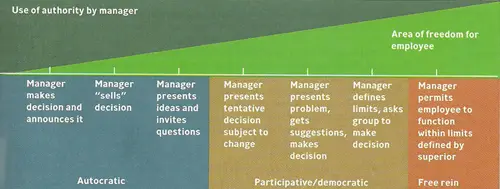Free-rein leadership, also called Laissez-Faire, is a type of leadership style in which leaders are hands-off and allow group members to make the decisions. Managers set objectives, and employees are free to do whatever is appropriate to accomplish those objectives. The traits managers need in such an organization include warmth, friendliness, and understanding. Free-rein is often the most successful style concerning the organization in which managers supervise doctors, engineers, professors, and other professionals.
Definition: Free-rein leadership is a style of leadership in which a leader allows group members to make decisions without interference.

Figure: Leadership Styles [1]
Primary Characteristics of Free-rein Leadership
The primary characteristic of the free-reign leadership style is a hands-off management approach to decision-making focused on: [2]
- Very little guidance from leaders
- Complete freedom for followers to make decisions
- Leaders provide the tools and resources needed
- Group members are expected to solve problems on their own
Benefits of Free-rein Leadership in Program Management
Free-rein leadership is typified by a leader who provides little advice or direction, giving team members a great deal of autonomy in making decisions and carrying out tasks. This leadership style in program management can provide several advantages:
- Promotes Creativity and Innovation: Team members are encouraged to think creatively and innovatively to solve problems, with little to no guidance from the leader. They are allowed to try new things and investigate various strategies, which may inspire innovative ideas.
- Promotes Ownership and Accountability: When team members can make their own decisions, they accept responsibility for their work. They take greater responsibility and are more dedicated to the project’s success because they believe they are responsible for the results of their efforts.
- Promotes Self-Development: By accepting a variety of duties and responsibilities, people with free-rein leadership can advance their knowledge and abilities. They can grow as professionals, learn from their mistakes, and gain experience.
- Boosts Morale and Motivation: Giving team members decision-making authority and a say in the project’s course can improve morale and motivation. Individuals are more likely to be involved and dedicated to reaching the program’s objectives when they feel trusted and respected.
- Adaptable to Dynamic Environments: A free-rein leadership style might work especially well in hurried or unclear situations. The program can adapt more effectively when team members can act fast in response to changes and make decisions without waiting for approval.
- Facilitates Collaboration and Communication: Team members are encouraged to interact and speak freely because there is less hierarchical control. They are able to freely share information, ideas, and criticism, which improves team chemistry and coordination.
- Reduces Micromanagement: Leaders can concentrate on more high-level, strategic activities when they adopt a free-rein leadership style, eliminating the need for micromanagement. By doing this, time and resources that could be used for other crucial program management components are freed up.
- Establishes Respect and Trust: In every team setting, trust is crucial. Leaders who trust their team members’ talents by granting them authority and honoring their judgments can build stronger bonds and promote a healthy work environment.
Downsides of Free-rein Leadership Include: [2]
Although free-rein leadership has certain advantages, leaders must find a balance and offer assistance and direction when required. The program’s success may be hampered by a loss of direction and control without adequate oversight. Team alignment with the program’s goals requires effective communication and regular check-ins.
- It is not ideal when group members lack the knowledge or experience to complete tasks and make decisions.
- Some people are not good at setting their own deadlines, managing their own projects, and solving problems on their own.
- Lack of feedback
- Miscommunication among managers and group members
Example of a Free-rein Leadership Style
A marketing manager exemplifies a free-rein leadership style with his employees when:
- The marketing manager’s objective for a new product line is to increase brand recognition and customer loyalty.
- Assigns the campaign’s budget and deadline and allows his employees to choose their own responsibilities, tasks, and methods for achieving the objective.
- Has faith in his employees’ ability to make independent decisions and solve their own problems without interference or micromanagement.
- Encourages them to approach him with any queries or requests for help.
- Evaluates their work and provides them with constructive criticism and commendation for their performance.
- Accepts responsibility for the outcome of the marketing campaign and recognizes his employees’ contributions.
Other types of leadership styles:
AcqLinks and References:
- [1] Nickels and McHugh, “Understanding Business” McGraw-Hill Irwin 2010
- [2] Website: About.com – Laissez-Faire
- Team Development Stages
Updated: 2/11/2024
Rank: 2.8
